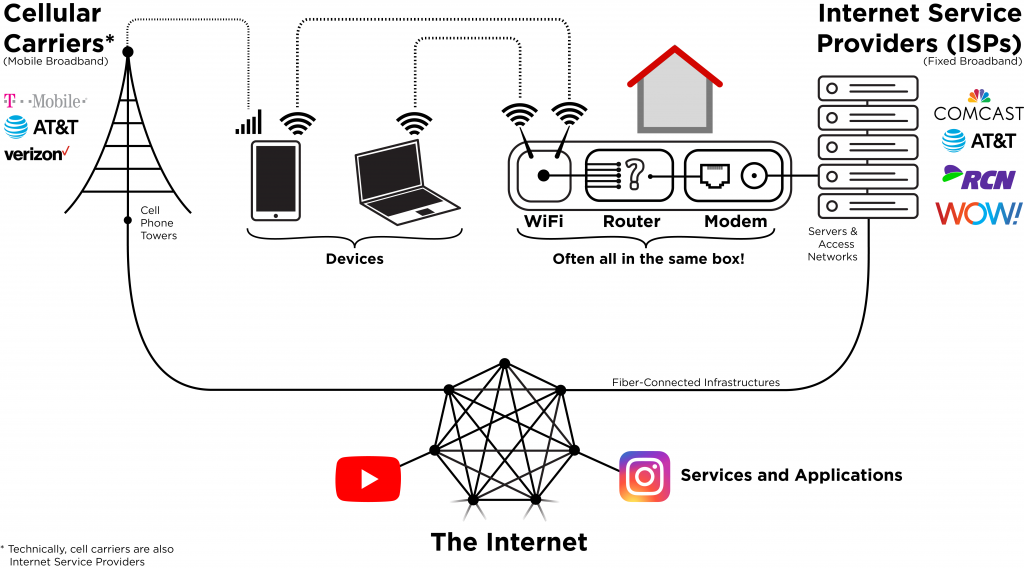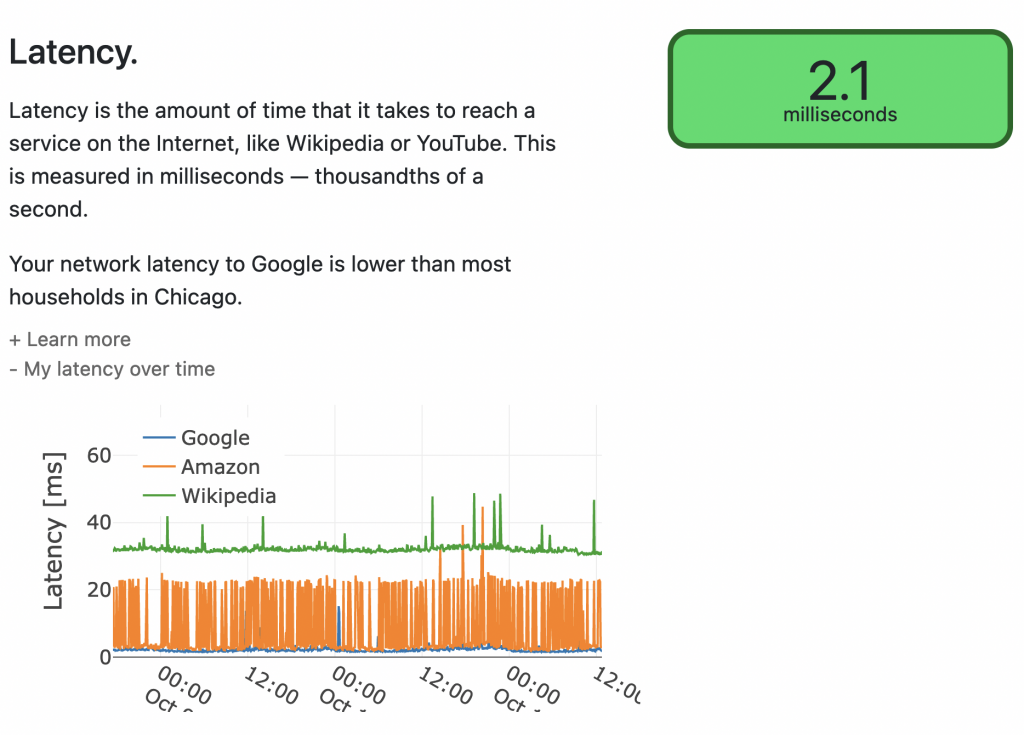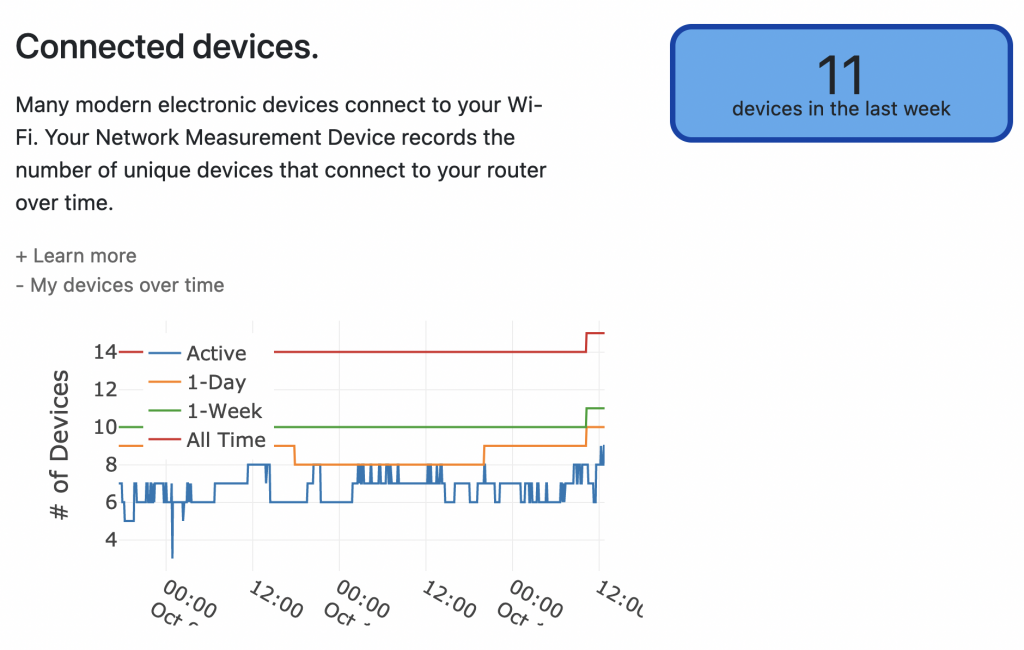What’s on Your Internet Performance Dashboard?
One focus of the University of Chicago Internet study is to collect measurements that will help you and the decision-makers in your community better understand Internet access and performance across Chicago. During the study, we will share blog posts that can help you learn more about your Internet experience. If you have topics or questions that you’d like us to address in these blog posts please share your ideas with us at broadband-equity@lists.uchicago.edu.

As part of the University of Chicago Internet study, we built an interactive Internet performance dashboard that displays data on your Internet connection collected by the measurement device that you have installed in your home. This personalized dashboard is only accessible to you. This post will explain the data displayed on your dashboard and how you can use it to learn about and improve your Internet experience. (For help on accessing your dashboard, visit our setup page.)
We encourage you to visit your dashboard on a regular basis to explore each indicator and how it changes or remains stable over time. At the very top of your dashboard, we also include a button that you can click on to report the quality of your Internet as you are experiencing it in real-time. Sending a quick update on your Internet experience can help us study which of these indicators, alone or in combination, determines whether your Internet is performing well or poorly.

The Internet Data on Your Dashboard
On your dashboard, we display four Internet performance indicators that can affect your Internet experience. These indicators are:
- the bandwidth of your Internet (Internet bandwidth)
- the bandwidth of your home Wi-Fi network (network bandwidth)
- the latency of your Internet connection (latency)
- the number of devices connected to your home Wi-Fi network (connected devices)
By navigating to your dashboard, you can view interactive charts showing each indicator over time for your Internet connection. Your dashboard also contains detailed descriptions for each indicator and an assessment of how your connection performs relative to other Internet connections in Chicago. Read on to learn more about each indicator.
Internet Bandwidth
The Internet outside of your home is made up of physical infrastructure like fiber and cable wires and servers. When you use the Internet, you are connecting to this infrastructure and are sending and receiving information from your connected devices to other destinations connected to the same infrastructure. For example, when you search for a place to eat on Google, you are sending your search query to Google’s servers over physical wires, which then transmit data back to your device (over those same wires) to give you the search results you want.

Internet bandwidth measures the speed at which information that you send over the Internet’s physical infrastructure travels to and from your Internet access point—that is, the modem that you have installed in your home and connected to your wall—over a fixed period of time (usually one second). If you think of the Internet connection as a highway and the information sent over that connection as cars, then your Internet bandwidth is the speed at which those cars are traveling on the highway.

Internet bandwidth is measured in megabits per second (Mbps) and can be further segmented into upload and download bandwidth. Upload bandwidth measures the speed at which information travels from your access point to other destinations outside of your home on the Internet (for example, uploading a video to YouTube). Download bandwidth measures the speed at which information travels from those destinations to your Internet access point (for example, streaming video from Netflix).
In short, you want your Internet bandwidth to be high to support things like fast content download, HD video streaming, and stable video conferencing. Generally, a download bandwidth of 50 Mbps and an upload bandwidth of 10 Mbps are sufficient to enable a high-quality Internet connection.
Network Bandwidth
In contrast to Internet bandwidth, network bandwidth measures the speed at which your home Wi-Fi network transmits data from the Internet access point inside your home to the devices connected to your Wi-Fi (also in Mbps). Your Wi-Fi network takes the information delivered to your Internet access point through the Internet’s physical infrastructure and converts it to a signal that can wirelessly send that information short distances to your connected devices. In other words, your network bandwidth measures the strength of the wireless signal inside your home.

Poor performance on your network bandwidth can degrade your Internet experience even when your Internet connection is fast. If your network bandwidth is lower than your Internet bandwidth, you will not be able to enjoy the full speed of the Internet service for which you pay. Factors that can affect your network bandwidth include the distance between your connected devices and the access point transmitting your Wi-Fi signal, whether there are walls and furniture blocking the signal between your access point and your devices, and the quality of the access point itself.
In short, you want your network bandwidth to be equal to or higher than your Internet bandwidth to experience the best Internet performance enabled by your service plan.
Latency
As explained above, bandwidth (both Internet and network) measures how fast your Internet connection can send and receive data in one second. In contrast, latency measures how many seconds in total it takes your connection to transfer a fixed amount of data to and from other destinations on the Internet outside of your home network.

Latency does not depend solely on your bandwidth. Other factors—such as how far away the destination to which you are sending data is from your access point (if you are located in the United States, it takes longer to send data to a server in China than to a server in California) and the amount of traffic on the Internet’s physical infrastructure in a given moment—can also affect your latency. The higher the latency, the less reliable your connection will be when using applications that require information to be quickly transmitted between your device and other destinations on the Internet, as is the case when you are on a Zoom call or when you are gaming online.
In short, you want low latency. Generally, a latency of 150 ms or less is sufficient to support intensive Internet applications like Zoom. (Source: https://support.zoom.us/hc/en-us/articles/202920719-Meeting-and-phone-statistics)
Connected Devices
The number of connected devices measures how many devices are using your home Wi-Fi network. Too many connected devices can negatively affect your Internet experience. Intuitively, if you have multiple members of your household on Zoom simultaneously, a large portion of your bandwidth will be occupied. Lots of devices using your Internet connection to upload and download information create network traffic that can degrade your Internet experience.

In short, you want to keep the number of devices connected to your network low for the best Internet experience.
Thank you for reading and we hope that this post can aid you on the path to improving your overall Internet experience! If you are interested in a deeper dive into this topic, please read the blog of one of our researchers, Jamie Saxon.